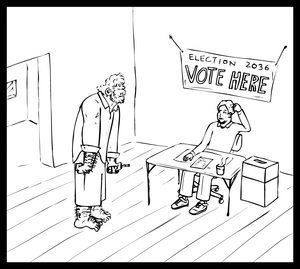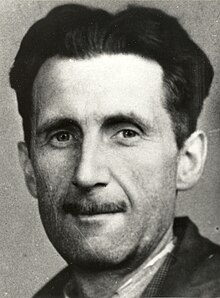
Introduction by Adrian Tawfik
Art has been the catalyst that has sparked many successful political reforms. In fact history is filled with examples of art attracting attention to an overlooked unfairness. Recall that it was a series of political cartoons by Thomas Nast that helped to bring about the downfall of New York’s corrupt political-party leader, William “Boss” Tweed. The book, The Adventures of Oliver Twist, by Charles Dickens lead to many overdue reforms in England—including banning child labor and abolishing debtor prisons—and these reforms have spread around the world. It was John Lennon’s simple lyrics “give peace a chance” that inspired a generation of young people to question the need for war. And George Orwell’s classic book Nineteen Eighty-Four continues to warn us against the horrific future for a world without democracy.
These works of art arose after the invention of the printing press and, in the case of the song, after the invention of audiotape recording technology. Now, the digital revolution has recently given us powerful new tools for creating art that can change minds. Let’s create democracy-focused art that uses these new digital tools. Not everyone can be in the right place at the right time to create smartphone video recordings and Internet-delivered words and images such as those that recently changed the course of history in the Middle East. Yet artists, of any type, can create democracy-inspired art, and our publication can help you get it to the eyes and ears of possibly millions of people.

We, at Democracy Chronicles, want you, our readers and viewers, to create YouTube videos of skits, poetry readings, artwork, still photographs, drawings, poems, haikus, brief stories, sculpture, and music that political activists can use to inspire and enlighten. We especially want artists to create videos that democracy reformers around the world can use to promote long-overdue political reforms.
Introducing Abe and Thomas
To help make this happen, what follows is a poem that demonstrates how art can be used to promote a democracy reform, namely using better election ballots. The poem tells a story about what could happen if Abraham Lincoln and Thomas Jefferson could come back to life and ran for President and Vice President as third-party candidates. Along the way, the poem unveils an overlooked reason as to why the United States has only two dominant political parties. The author of this poem, Richard Fobes, has given permission for the words of this poem to be used in any video, as long as the message of the poem is not changed to a different message.
Imagine how much more powerful this poem would become if the words were shared through an entertaining YouTube video. That is something we invite you to do.
If you aren’t sure what to do, you can make a video of yourself, or someone else, reciting the poem. Or if you have a theatrical orientation, you and friends can perform a skit that is based on the story in the poem. Or perhaps you can create an animated version. Then tell us where to find your video!
If you aren’t inspired to do something with this poem, then please begin to think about creating something that does inspire you to create a video. Perhaps you can create your own story about a famous politician in history trying to win an election under current conditions.
Remember that the goal is to create a video that’s entertaining and helpful to the democracy movement. We are hoping for some truly original videos—so get creative and have fun creating a YouTube-video version of this poem.
Instead of using media to bombard people with ignorance, distractions, and misinformation, let’s demonstrate what media really should be, namely relevant, truthful, and inspiring, and occasionally served with humor and lightheartedness. Enjoy!
Abe and Thomas for President
A poem by Richard Fobes
‘Twas the night before campaigning, and all through the nation politicians’ bank accounts bulged in anticipation. The voters were couched watching shows on TV with dreams of finance reform restoring democracy, while top party leaders planned rhetoric to hide the wide gap between voters and the wealthy at their side.
The marble statue of Lincoln on the mall in D.C. watched Congress being influenced by legal bribery. On that warm summer night at the memorial to Lincoln a few tourists were shocked when his eyes started blinkin’. Then larger than life Lincoln arose with a clatter. Smelling the air, Abe said “I’ll fix this matter.”
At the memorial to Jefferson he gave Tom a nudge. Tourists gasped to see move what they thought wouldn’t budge. “Democracy’s been lost, the voters are ignored, the rich vote with dollars ‘n get a bigger reward,” the two ex-presidents nodded and agreed, “A wise un-moneyed alternative is what voters need.”
To the delight of voters, the two entered the race with Lincoln for prez and Jeff in second place. They promised to voters what contributors had blocked, such as gun laws that only the NRA knocked, and stopping timber sales for a few bucks a tree on government lands using logging roads free.
“Just look,” said Thomas “at the biggest contributors: the lawyers and doctors, the military contractors, pharmaceuticals, bankers, the insurance industry, all backing lobbyists who stalk the halls of D.C. While paying Congress for legalized monopoly, they block health care reform and a stronger economy.”
So Jefferson put forth wise solutions from his brain, but between ads, media’s agenda was to entertain. They chose sound bites that distorted speeches Abe gave, and dug into stories ’bout (widower) Tom’s mistress, a slave. Of mudslingin’ reports, smart voters were bored, so for unbiased info went to votesmart dot org.
Becoming scared by Abe’s and Thomas’ success, the campaign contributors increased their largess. The more they opposed the voters’ agenda, the more they became an even bigga’ spenda’. From owners of casinos, dealers in tobacco, and stock marketeers, more money did flow.
In spite of the money that went into the race, the big-party candidates couldn’t keep pace. They lost more ground in the presidential debate, so when election day came the excitement was great.
Finally, fifty eight percent put Abe first of three, twenty four for the elephant, and eighteen for the donkey. With the Electoral College rules and their vagary this became forty five, thirty two, and twenty three.
Lacking a majority, the Constitution was consulted. Most people were surprised at what resulted. In this case, which happened just twice in history, the house of representatives vote among the top three, with a surprising twist: each state gets one vote. Realizing this, voters lost what was left of their hope.
House Republicans and Democrats all voted for their own, so the voters once more had a reason to groan; not one vote was cast for the voter’s top choice. Instead, the elephant’s pick was the one to rejoice. So party backers celebrated continued monopolies, their tax-paid subsidies, and anti-voter priorities.
Abe and Tom, for advanced voting methods did promote. “You now have computers, so voters can vote for more than one choice,” said Tom fervently. “Try it out at VoteFair dot org and you’ll see that VoteFair produces a fair outcome for you when, in a race, there are candidates more than two.”
“We certainly know it won’t happen soon, but longer we’ll wait ’til a time opportune. We’ll rise once again if the need should be there. With VoteFair ranking the results will be fair.” With that Abe and Tom turned back into stone, and waited for voting to reach that milestone.
Now voters understood why only two parties exist, and realized fair voting bypassed funding influence. So VoteFair ranking was used in board elections, then elections in cities, counties, and corp’rations, then elections for senators and reps from each state, while Lincoln and Jefferson continued to wait.
FIN
© Copyright 1999, 2000, 2006 by Richard Fobes, the author of The Creative Problem Solver’s Toolbox and the inventor of VoteFair ranking as described at www.VoteFair.org and available (for free) as open-source software at VoteFair-ranking. If the message of the poem is not changed, then you have permission to copy and perform and distribute this poem. All other rights are reserved.
Richard Fobes is the author of several books including, “The Creative Problem Solver’s Toolbox”.
Please see our interview series concerning election-method reform that can be found here. Also, take a look at our interview with Mr. Fobes about his views on election reform and election methodology that can be found here. You can see more artwork like this great poem at Democracy Chronicles’ Political Art section.
Leave a Reply